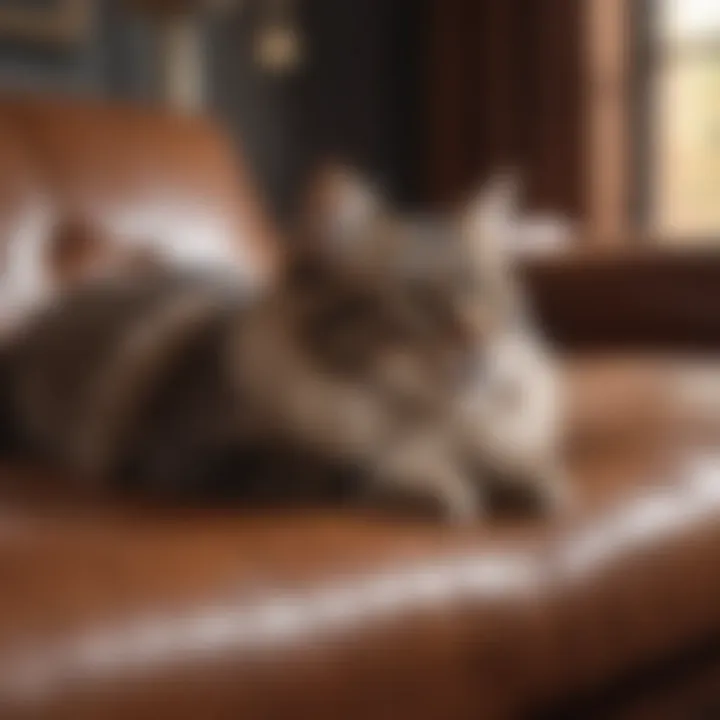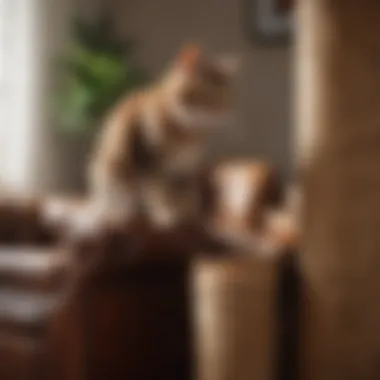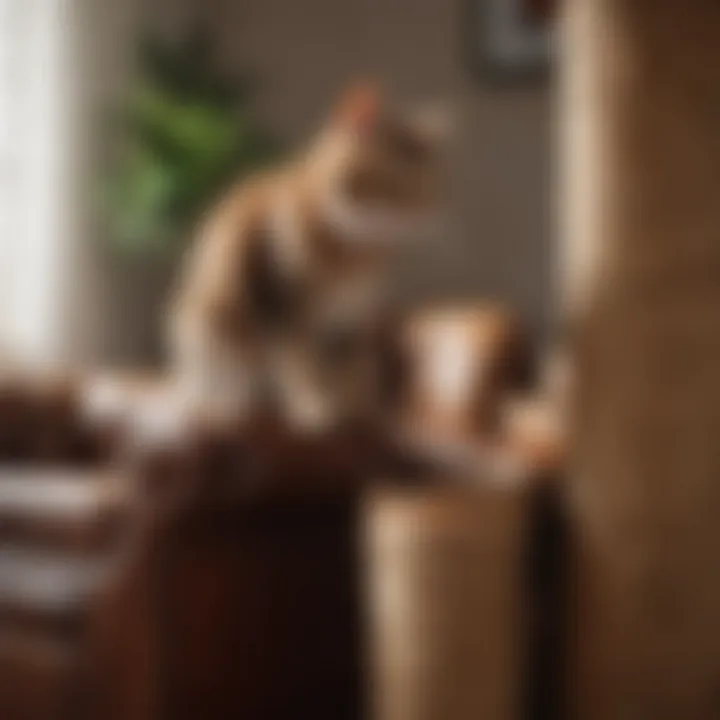Top Strategies to Protect Leather Furniture from Cats


Intro
Leather furniture can be a beautiful addition to any home, but it also presents a unique challenge for cat owners. Understanding the feline nature is key to protecting your investments. This article delves into effective and practical strategies to prevent cat damage to leather surfaces. From behavioral training to the exploration of natural and commercial cat repellents, this guide aims to arm you with knowledge and tools necessary to enjoy both your pets and furniture simultaneously.
Pet Care and Grooming
Importance of Regular Care
Regular grooming plays a crucial role in maintaining the health of both your cat and your furniture. Cats shed fur, and their nails can cause damage if left unchecked. Establishing a grooming routine helps minimize shedding and reduces the chances of your cat being bored and seeking destructive outlets.
Grooming Techniques by Pet Type
Different breeds have different grooming needs. Long-haired cats require more frequent brushing to prevent matting. Short-haired cats, while easier to manage, still benefit from occasional grooming to remove loose fur. Understanding these differences can help prepare you to meet your cat's specific needs effectively.
Tools and Products Recommendations
Investing in proper grooming tools is essential. A good quality brush, nail clippers, and even grooming wipes can make a significant difference. Brands like FURminator and Pet Groomers Toolbox offer an array of products tailored for various cat types. These not only help with grooming but also encourage bonding between you and your pet.
Seasonal Care Tips
Seasonal changes can affect grooming needs. For example, during the warmer months, your cat may shed more excessively, requiring additional brushing. Conversely, in winter, a cat may develop a thicker coat, necessitating less frequent grooming. Keeping an eye on these changes will help you adjust your habits accordingly.
Health and Nutrition
Understanding Pet Nutrition
A balanced diet is vital for your cat's overall health. High-quality cat food will help maintain a shiny coat and healthy skin, reducing shedding and potential damage to your furniture. It is essential to read labels and choose foods with meat as the main ingredient.
Common Health Issues by Species
Be mindful of common health concerns such as obesity, skin allergies, and dental issues. These can lead to behavioral changes, including excessive scratching or biting, which may target your furniture. Regular vet check-ups can help identify and address these issues early.
Preventive Care and Regular Check-Ups
Routine veterinary visits ensure your cat stays healthy and any potential problems are addressed swiftly. This also helps in keeping your leather furniture safe by preventing behavioral issues arising from discomfort or pain.
Food and Dietary Advice
Consultation with a veterinarian regarding diet can be beneficial. They can suggest specific dietary adjustments based on your cat's individual health needs. This approach not only fosters health but also influences behavior, leading to less destructive tendencies.
Behavioral Training
Basics of Positive Reinforcement
Using positive reinforcement techniques is crucial in training your cat. Rewarding good behavior with treats, praise, or playtime encourages them to engage in desirable actions rather than destructive ones.
Training Techniques Users Can Apply
Some effective training techniques include clicker training and target training. These methods involve using a clicker or specific object to guide your cat toward desired behaviors. Practicing consistency is key in achieving success in training sessions.
Managing Behavioral Issues
Recognizing and addressing behavioral problems early on can prevent further issues. For example, if your cat scratches leather furniture, it may be due to boredom or lack of stimulation. Engaging them with toys or creating designated scratching areas can mitigate this.
Importance of Socialization
Cats need social interactions to thrive. Regularly introducing your cat to various people and environments can foster a well-adjusted pet, reducing anxiety and potential destructive behaviors.
Preamble to Cat Repellents
The issue of cat repellent solutions is critical for anyone who owns leather furniture and values its aesthetic and functional qualities. Cats are naturally drawn to scratch and play, and leather can be a target for their intentions. Understanding this behavior is the first step in safeguarding your furniture. In this section, we will explore the relevance of cat repellents, how they function, and their importance in maintaining your living environment.
Effective cat repellents serve a dual purpose: they protect your furniture while also considering the well-being of the animal. Employing these strategies can help minimize the risk of damage, thus extending the life of your leather pieces. Moreover, a clear comprehension of the options available can empower you to make informed decisions that align with your preferences and your cat's behavior.
Understanding Cat Behavior
To effectively deter cats from leather furniture, it is essential to understand their instincts. Cats are territorial and curious animals. They often scratch surfaces to mark their territory, exercise, or simply to explore their environment.
- Instinctual Behavior: Scratching is not just a habit; it is a natural behavior for cats. They have specific needs that must be met, such as stretching their muscles and keeping their claws healthy.
- Curiosity and Play: Cats are also playful and inquisitive. They may be drawn to the texture and scent of leather furniture, seeing it as an attractive part of their territory or a suitable spot for a cozy nap.
Understanding these motivations is vital to choosing the right repellent methods. Instead of only focusing on deterrents, an approach that considers the feline needs may often yield better results, helping to create a harmonious space where both furniture and cats coexist.
Understanding what drives feline behavior can set the foundation for effective deterrent strategies.
As we delve deeper into types of repellents and training techniques, remember that the ultimate goal should be a balance between protecting your leather furniture and ensuring your cat’s comfort and well-being.


Types of Cat Repellents
Choosing the right cat repellent is essential for protecting leather furniture from scratches and damage. The effectiveness of repellents varies depending on the type used, whether natural or commercial. Understanding the options allows pet owners to select the best solution for their needs.
Natural Cat Repellents
Natural cat repellents are often favored due to their non-toxic nature. They provide a safer environment for both cats and humans, while still deterring unwanted behaviors.
Essential Oils
Essential oils are concentrated plant extracts known for their strong scents. Common choices include lavender, peppermint, and eucalyptus. These oils can be an effective deterrent because cats generally dislike strong odors. A key characteristic of essential oils is that they can also provide a pleasant aroma for humans. However, they require careful use; some oils can be harmful to cats if ingested or improperly applied. Therefore, dilution with a carrier substance is crucial when using essential oils.
Vinegar Solutions
Vinegar solutions consist of water mixed with white vinegar. This simple mixture has a strong smell that can deter cats. The acidic nature of vinegar also helps to neutralize odors, making this solution practical. It’s popular as it is inexpensive and easy to make. However, the scent of vinegar can be off-putting to humans as well, which may limit its use in living areas. Moreover, it may cause some staining on porous surfaces, making testing on a small area advisable.
Citrus Scents
Citrus scents, such as lemon and orange, are natural cat repellents. Many cats are known to dislike these fragrances, making them effective in keeping felines away from furniture. A key benefit of citrus is its refreshing aroma for humans, which contrasts with the pungent smell of other solutions. Citrus can be applied in various forms, like peels or essential oils. However, some cats may be sensitive, so caution is advised as it may irritate their skin or respiratory system.
Commercial Cat Repellents
Commercial cat repellents offer a wide range of choices, each with specific features that can effectively protect leather furniture. They are designed to be convenient and straightforward for pet owners.
Sprays
Sprays are one of the most common commercial repellents. They are easy to apply and can coat surfaces evenly. The formula often contains scent or bitter agents to deter cats effectively. Sprays are beneficial because they provide immediate protection and can be reapplied as needed. However, their effectiveness may diminish over time. Frequent use can also lead to a buildup that might affect the leather's appearance, requiring owners to clean surfaces regularly.
Granules
Granules are another option. They can be strategically placed around furniture or in targeted areas. Their characteristic lies in their slow-release property, which can provide long-lasting deterrence. Granules are particularly useful outdoors but can also be effective inside a home. One disadvantage is that they may pose a choking hazard to pets or children, thus requiring careful placement.
Electronic Deterrents
Electronic deterrents are devices that use sound or motion sensors to ward off cats. They can be effective in repelling cats without the use of chemicals or scents. A unique feature is their automatic response to feline movement, which helps ensure ongoing protection. However, they may require batteries or electrical power, which adds to maintenance needs. Some cats might also become accustom to the devices over time, limiting their effectiveness.
Factors to Consider When Choosing a Cat Repellent
Selecting an effective cat repellent involves careful consideration of several factors. Each cat is unique, and what works frequently varies based on individual behavior, sensitivities, and the environment. Therefore, understanding these factors helps you choose a solution that is safe, efficient, and tailored for your leather furniture.
Safety for Pets
When choosing any cat repellent, safety should be the foremost concern. Cats are curious creatures who tend to explore everything around them. As such, it is essential to avoid products that contain harmful chemicals or irritants. Natural products are often perceived as safer, but even these can provoke allergic reactions in sensitive cats.
Before applying any repellent, check for labels indicating toxicity levels or harmful ingredients. Ideally, choose repellents that are specifically labeled as pet-safe. For instance, citrus-based repellents may deter cats, but they could also cause digestive issues if ingested. Always consult with a veterinarian if you are unsure about the safety of a specific product.
Impact on Leather Material
The interaction between cat repellents and leather requires special attention. Leather is a delicate material which can suffer damage from harsh substances. For example, some commercial sprays may contain alcohol or strong solvents that can cause discoloration or drying.
To minimize potential damage, test the repellent on a small, inconspicuous area first. Observe any changes in color or texture before proceeding with a full application. Additionally, some natural repellents such as diluted vinegar can leave lingering scents which might not be appealing to both you and your cat. Knowing the impact on leather ensures that your protective instincts do not inadvertently harm your valuable furniture.
Key Takeaway: Prioritize both safety for your pets and the integrity of your leather furniture when selecting a cat repellent. A careful approach will allow you to protect your assets without compromising the well-being of your feline companions.
Applying Cat Repellents on Leather Furniture
Applying cat repellents on leather furniture is a crucial consideration for pet owners seeking to protect their investments. Cats, with their natural instincts to scratch and climb, may find leather furniture irresistible. Therefore, understanding how to use repellents effectively not only safeguards your furniture but also maintains a harmonious relationship with your feline companions.
In this section, we will delve into various aspects of applying cat repellents. We will cover the preparations that should be made prior to application, effective techniques for the application itself, and considerations that can enhance the overall efficacy of the repellents used.
Pre-Application Preparations
Testing on Small Areas
Testing on small areas serves as a preliminary step before applying cat repellent across the entire piece of furniture. This practice involves applying a small amount of the repellent to an inconspicuous area to observe any adverse reactions. This approach allows you to ascertain the product’s compatibility with your leather material. If the leather reacts poorly, such as discoloration or damage, this method saves both time and money in the long run.
One key characteristic of testing on small areas is its preventive nature. It offers a level of caution and reassurance, which many pet owners find beneficial. Additionally, it minimizes the risk of damaging the entire piece, should there be any negative effects. However, this method does require patience, as it extends the overall process of preparing your furniture for the repellent application.
Cleaning the Surface
Cleaning the surface is another essential preparation step before applying any cat repellent. Dirt, oils, and other residues can hinder the effectiveness of the repellent and may lead to uneven application. A clean surface ensures that the repellent adheres appropriately, maximizing its protective qualities against cats. This step involves using a gentle cleaner designed specifically for leather, followed by thorough drying with a soft cloth.
The unique feature of cleaning the surface is that it not only prepares the leather for protection but also contributes to its longevity. Regular cleaning can bring out the true beauty of the leather while maintaining its integrity. However, it is important to choose the right cleaner, as using harsh chemicals may have harmful effects on the leather surface.
Effective Application Techniques
Even Distribution


Even distribution of the cat repellent is vital for achieving optimal results. Applying the product uniformly helps create a consistent barrier against cats, minimizing the chances of them finding uncovered areas they can scratch or cling to. This technique is beneficial because it reduces the likelihood of cats returning to the same spot.
A practical aspect of even distribution is the use of spray bottles for liquid repellents, which allows for controlled application. The advantage of this method lies in its efficiency, as a well-distributed product will work effectively across the entire surface. The drawback here is that it may require some practice to get the hang of it, especially for first-time users.
Frequency of Application
Lastly, understanding the frequency of application is essential for maintaining a protective barrier on your leather furniture. Different types of repellents may have varying recommendations for how often they should be reapplied, typically ranging from daily to weekly. This ensures that the scent or effect remains potent enough to deter your feline friends.
The unique feature of knowing when to reapply allows pet owners to adjust their maintenance routines based on their cats' behaviors. However, a potential disadvantage is that frequent applications may lead to buildup or changing the surface quality of the leather if not managed properly.
Regular monitoring of both the repellent's effectiveness and your cat's behavior will help you decide the right frequency for your circumstances.
In summary, applying cat repellents effectively involves careful preparation and execution of techniques. Pre-application preparations like testing small areas and cleaning surfaces, combined with effective application techniques such as even distribution and understanding frequency, can lead to successful outcomes in protecting leather furniture from cat damage.
Training Your Cat to Avoid Off-Limit Areas
Training your cat to steer clear of specific areas in your home, particularly leather furniture, is vital for both the cat's wellbeing and the condition of your home. Cats are naturally curious and instinctive creatures, often drawn to explore every inch of their environment. This exploration can lead to unwanted scratches or damage to leather furniture. Therefore, implementing a training routine and setting clear boundaries can be beneficial.
Positive Reinforcement Techniques
Positive reinforcement involves rewarding your cat for desired behaviors. This method proves effective because cats respond well to their instincts when they associate actions with rewards.
Here are several techniques:
- Treats: When your cat avoids the off-limit areas, offer a small treat as an immediate reward. This creates a positive association.
- Praise: Use a soft voice and gentle petting when they comply with your training. Cats appreciate affection and will remember the praise associated with specific actions.
- Interactive Play: Engage your cat with toys in approved areas. Redirecting their attention can help them learn where they are allowed to go.
Consistency is key. Repeating these cues to reinforce learning will create a long-lasting impact. It is important to remain patient while training. Cats may take time to adjust to new rules.
Setting Up Deterrent Boundaries
Establishing clear physical boundaries helps reinforce where your cat can and cannot go. This method naturally complements training. When your cat begins to feel secure in knowing specific areas are off-limits, they are less likely to attempt exploring them.
Consider these strategies:
- Furniture Covers: Use protective covers or throws on leather furniture. This not only protects the material but helps your cat recognize that these areas are not meant for them.
- Physical Barriers: You may set up gates or temporary barriers when necessary. This can deter access to specific regions of your home, effectively training your cat to avoid those spaces.
- Scent Deterrents: Utilize specific scents that cats dislike around off-limit areas. Spraying diluted vinegar or using citrus scents may make certain zones less appealing.
Regular implementation of these techniques fosters an environment where your cat learns boundaries without stress. They become accustomed to their environments and what is expected of them.
Alternatives to Repellents
When it comes to protecting leather furniture, it's crucial to consider alternatives to traditional cat repellents. While repellents can be effective, they might not always provide a long-term solution. Therefore, exploring alternatives can help create a holistic approach to safeguarding furniture without compromising the comfort of your pet. These strategies can minimize damage while fostering a more harmonious living space.
Covering Leather Furniture
Using Throws
Using throws is a practical solution for protecting leather furniture. These can be draped over sofas and chairs, acting as a barrier against scratches and potential stains caused by cats. A significant characteristic of throws is their versatility. They come in various materials, colors, and patterns, allowing you to choose one that matches your decor. This adaptability makes using throws a popular choice for pet owners.
The unique feature of throws lies in their ease of maintenance. Most can be washed and reused without any special care, making them a cost-effective option. However, they may require frequent adjustments as they can slide off easily during use. Overall, throws provide both a protective measure and an aesthetic enhancement to your living space.
Leather Protectors
Leather protectors are another alternative worth considering. These products are designed specifically to safeguard leather surfaces from scratches and spills. A key characteristic of leather protectors is their ability to form a protective barrier without altering the material's appearance.
Using leather protectors offers several benefits. They typically repel water and are resistant to stains, thus prolonging the life of the leather furniture. However, it is essential to choose a product that is compatible with your specific type of leather. Improper use could potentially lead to discoloration or damage. Therefore, following the manufacturer's instructions is crucial.
Providing Cat-Safe Zones
Creating cat-safe zones is an effective strategy to redirect your pet's behavior away from furniture.
Scratching Posts
Scratching posts are a vital element in providing appropriate outlets for your cat's natural scratching behavior. These structures encourage felines to engage in scratching activities that preserve your leather furniture. A notable characteristic of scratching posts is that they can be made from multiple materials, such as sisal, carpet, or cardboard, appealing to various feline preferences.
The unique advantage of scratching posts is their ability to satisfy your cat's instincts while protecting your home decor. However, placement is important; ensuring they’re in areas where your cat likes to scratch can make them much more effective. Without the right positioning, you might find your cat sticking with the leather furniture instead.
Cat Furniture
Cat furniture encompasses a range of products designed to meet a cat's needs while safeguarding household items. This type of furniture often includes climbing trees, condos, or play gyms. A key characteristic of cat furniture is its design, which typically allows it to blend into home decor while serving the cat's entertainment needs.
The unique advantage of having dedicated cat furniture is that it can keep your cat engaged, potentially reducing the chances it will scratch leather surfaces. However, it may require space in your home, and its upfront cost can be relatively high. Nonetheless, investing in cat-friendly spaces can lead to a more peaceful coexistence between pets and human environments.
Building a pet-friendly home does not mean sacrificing style. Careful planning and thoughtful product choices can help maintain both aesthetics and functionality.
Evaluating the Effectiveness of Cat Repellents
Evaluating the effectiveness of cat repellents is crucial in maintaining the integrity of leather furniture while coexisting with feline companions. Understanding how different repellents work helps pet owners make informed choices to safeguard their belongings. Effective evaluation often includes monitoring behavioral changes in cats in response to the chosen deterrents.


Monitoring Cat Behavior
Observing cat behavior is key in assessing how well a repellent is functioning. Changes in a cat's habits can indicate whether the chosen product is effective or if new strategies need to be employed. Here are some aspects to consider when monitoring:
- Interactivity with Furniture: Pay attention to whether your cat still approaches the furniture or if it avoids it entirely. A noticeable avoidance pattern suggests that the repellent is working.
- Stress Reactions: Look for signs of stress in your cat. If the repellent causes distress, it could be counterproductive. Adjustments may be necessary.
- Trial Duration: Give the process enough time. It might take several days for a cat to adjust to a new deterrent, so be patient and consistent in monitoring.
Understanding these changes offers insight into the efficacy and potential areas needing adjustment.
Adjusting Techniques as Necessary
Sometimes, a single method may not suffice to deter cats effectively. Hence, it is essential to be flexible and ready to adjust techniques as needed. Here are some approaches for making those adjustments:
- Evaluate Effectiveness: If the current repellent does not seem to work, consider switching to different methods, either natural or commercial.
- Combine Strategies: Using multiple deterrent techniques can enhance effectiveness. For example, combining a spray with physical barriers can provide a layered defense.
- Reassess Training: Sometimes, behavioral training techniques alongside repellents provide a more holistic solution. Positive reinforcement might be necessary to encourage desired behaviors.
- Frequency of Application: Ensure that the repellent is being reapplied as recommended. Some products lose effectiveness over time. Observations post-reapplication can guide future decisions.
Before making changes, document what strategies were used and their observed effects to avoid repeating ineffective approaches.
Potential Challenges with Cat Repellents
Understanding the potential challenges with cat repellents is important for effective application and lasting solutions. Many pet owners face difficulties when trying to protect their leather furniture from cat behavior. This section delves into some common issues that arise with repellents and discusses how to navigate these challenges.
Resistance to Deterrents
Cats are known for their independent nature. This can lead to a resistance to deterrents that pet owners may employ. If a cat consistently experiences something, it may become less effective over time. For instance, a cat might initially be deterred by a certain scent but may eventually become accustomed to it or even find comfort in it. This phenomenon complicates the use of commercial sprays or natural deterrents.
Factors influencing a cat’s resistance include:
- Repeated exposure: Frequent contact with the same repellent can lessen its impact.
- Individual sensitivity: Different cats react uniquely based on their experiences and personalities.
- Behavioral habits: Cats may develop routines that involve ignoring deterrents altogether.
To combat this resistance, owners might consider rotating different types of repellents or mixing applications. Engaging in specific behavioral training techniques alongside deterrents can also help improve effectiveness.
Scent Sensitivity Issues
Scent sensitivity is another challenge pet owners may encounter. Cats possess a keen sense of smell, making them sensitive to various scents that may not bother humans. Some commercial repellents use strong or harsh chemicals, which can be overwhelming for cats. This could lead to stress or anxiety, making the situation worse.
Common problems regarding scent sensitivity include:
- Overwhelming fragrances: Some repellents contain odors that can irritate a cat’s nose.
- Potential allergic reactions: A cat may develop allergies to certain ingredients found in repellents.
To mitigate these issues, owners should seek out milder alternatives, such as natural cat repellents containing essential oils or vinegar. Proper ventilation during and after applying these solutions can minimize the scent impact for sensitive felines. Furthermore, testing a small area before applying any product extensively is prudent.
Ensuring the chosen repellent is as effective as possible while still considering the cat's well-being is essential for maintaining a peaceful home.
Navigating these challenges requires patience and adaptability. Owners should remain vigilant and assess the responses of their cats regularly. By being aware of resistance and scent sensitivity, pet owners can advocate for the best solutions to protect their leather furniture effectively.
Long-Term Maintenance Strategies
Maintaining the integrity of leather furniture in a household with cats requires a well-planned long-term strategy. Without consistent care, even the best cat repellent solutions may fall short. Long-term maintenance is crucial for several reasons. It ensures that protective measures remain effective over time, helps in reducing the need for extensive repairs, and creates a more harmonious living environment. Regular attention can prevent the development of habits in cats that lead to unwanted behavior.
Periodic Reapplication of Repellents
Once you establish a regime with your chosen cat repellent, it is vital to reapply the solution regularly. The effectiveness of most commercial and natural repellents diminishes with time, often due to environmental factors like air flow or humidity. Therefore, a set schedule for reapplication is recommended. Depending on the specific product, this may range from every few days to once a month.
- Commercial Sprays: Typically need reapplication every 1-3 days, especially in high-traffic areas.
- Natural Solutions: These often have a shorter longevity and may require daily applications.
- Always follow manufacturer's instructions to ensure the product works as intended.
Reapplication not only helps maintain the deterrent effect but may also reinforce your cat’s understanding that certain areas are off-limits.
Regular Cleaning and Upkeep
Cleaning leather furniture is essential in the long-term maintenance strategy. Regular cleaning serves two main purposes: it removes any residual scents or oils that may attract cats, and it ensures that the furniture remains in top condition. Depending on usage, cleaning should be done routinely, perhaps weekly or bi-weekly. It is important to use appropriate leather cleaners to avoid damage.
- Vacuuming: This should be done to remove hair and dirt that can accumulate on leather surfaces.
- Wiping Down: Use a damp, soft cloth to absorb sticky spills and grime immediately.
- Conditioning: Apply a leather conditioner at least once every six months to keep the material supple and prevent cracks.
By combining periodic reapplication of repellents with regular cleaning and upkeep, pet owners can create an environment where the furniture is protected from cat-related wear and tear. These strategies contribute significantly toward maintaining the aesthetics and durability of leather furniture over time.
Staying proactive can help avoid potential damages, reducing costs and stress in the long run.
Epilogue
Understanding cat repellent solutions is crucial for protecting leather furniture. As pet owners, we hold a responsibility to create an environment that minimizes damage while keeping our pets safe. The right strategies balance the need for deterrence and the consideration of feline behavior.
Evaluating the various types of cat repellents—both natural and commercial—allows for informed choices based on effectiveness and safety. Natural solutions, while appealing for their non-toxic nature, may not always offer the results desired. On the other hand, commercial products provide targeted effectiveness but can have implications for both the cat and the leather surface.
Incorporating training techniques further complements the use of repellents. By reinforcing desired behaviors and creating cat-safe zones, pet owners can establish a more harmonious living space. It enables a unified approach toward protecting furniture while accommodating the needs of our feline companions.
Factors such as scent sensitivity and the potential for resistance to deterrents underline the necessity for tailored solutions. Regular assessment of chosen methods ensures a proactive stance against furniture damage.
Ultimately, the commitment to long-term strategies, including periodic reapplication of repellents and maintenance of the furniture, sustains a protective barrier over time. This holistic approach aids in achieving the dual objectives of maintaining the integrity of leather furniture and fostering a suitable environment for our pets.
Summary of Key Takeaways
- Balancing Protection and Safety: Consider the safety of pets when selecting repellents.
- Natural vs. Commercial Options: Weigh the pros and cons of both types of repellents based on needs.
- Behavioral Training: Train cats with positive reinforcement to avoid designated areas.
- Long-Term Maintenance: Regularly reapply repellents and clean furniture to ensure continued protection.
- Customized Approaches: Tailor strategies based on the cat's behavior and sensitivity.
Establishing these measures not only protects your furniture but also nurtures the bond between you and your pet.















